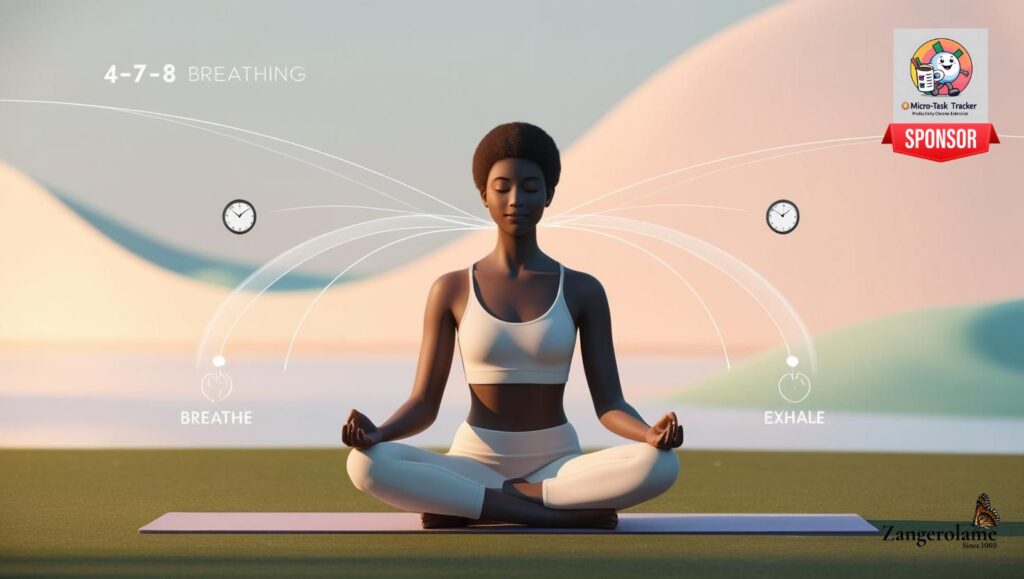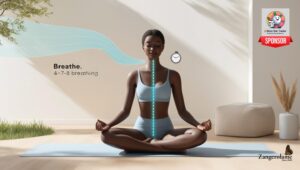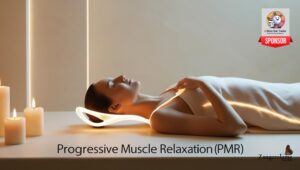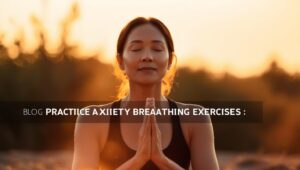5 Instant Anxiety-Relief Techniques You Can Use Anywhere

5 Instant Anxiety-Relief Techniques You Can Use Anywhere
Anxiety can creep up at the most inconvenient times—whether you’re navigating a stressful work meeting, stuck in rush-hour traffic, or even waiting in line at the grocery store. That familiar tightness in your chest, racing thoughts, or pounding heart can make you feel trapped in the moment. The good news? You don’t need hours, expensive tools, or a quiet retreat to find relief. These five instant anxiety-relief techniques are simple, science-backed, and can be done anywhere, no preparation required. From calming your body to refocusing your mind, these strategies will help you regain control fast.
If you’re feeling overwhelmed by a growing to-do list, the free Micro-Task Tracker Chrome extension or Firefox Add-On can help you break tasks into manageable steps, reducing stress before it spirals. Ready to discover quick ways to calm anxiety? Let’s dive into the techniques that can transform your day.
Why Instant Anxiety Relief Matters
Before we explore the techniques, let’s talk about why quick anxiety relief is so crucial. Anxiety often strikes unexpectedly, triggered by anything from a looming deadline to a crowded social setting. According to the National Institute of Mental Health, nearly 31% of adults experience an anxiety disorder at some point, and many face daily moments of stress that disrupt focus and well-being. Left unchecked, these moments can snowball, affecting productivity, relationships, and even physical health.
Instant relief techniques work by interrupting the body’s stress response—specifically, the activation of the sympathetic nervous system, which triggers the “fight or flight” mode. By engaging the parasympathetic nervous system (the “rest and digest” mode), these methods lower heart rate, ease muscle tension, and quiet racing thoughts. The best part? They’re discreet, portable, and take just minutes to work.
Whether you’re at work, home, or on the go, these five techniques will empower you to reduce anxiety immediately. Let’s explore each one in detail, with step-by-step instructions, practical tips, and tools to enhance your experience.
1. Deep Breathing with the 4-7-8 Technique
What Is It?
The 4-7-8 breathing technique is a powerful, science-backed method to calm your nervous system in under a minute. Developed by Dr. Andrew Weil, this practice is rooted in pranayama, an ancient yogic breathing tradition. It’s simple enough to do anywhere—your car, a meeting, or even a noisy coffee shop—and requires no equipment. 

How to Do It
Follow these steps:
-
Inhale quietly through your nose for 4 seconds, feeling your belly expand.
-
Hold your breath for 7 seconds, allowing your body to pause.
-
Exhale slowly through pursed lips for 8 seconds, making a soft “whoosh” sound.
-
Repeat the cycle 3-4 times, or until you feel a sense of calm.
If you’re new to this, start with shorter counts (e.g., 3-5-6) and gradually work up to 4-7-8. The key is to keep your breathing slow and controlled.
Why It Works
The 4-7-8 technique reduces anxiety fast by regulating your body’s stress response. Research published in the Journal of Clinical Psychology shows that controlled breathing lowers cortisol levels and heart rate, signaling your brain to exit “panic mode.” The extended exhale also increases oxygen flow, promoting relaxation. Over time, this practice can even improve sleep and resilience to stress.
Practical Tips
-
Set a rhythm: Use a timer or count silently to stay on track.
-
Enhance with apps: Apps like Calm or Insight Timer offer guided 4-7-8 sessions for beginners.
-
Practice daily: Even 2 minutes a day can make this technique second nature, so it’s ready when anxiety hits.
-
Create a calm space: For a distraction-free experience, play my 10-hour black screen YouTube video. Its soothing silence helps you focus on your breath without interruptions.
When to Use It
This technique shines in moments of acute anxiety—think before a presentation or during a tense conversation. It’s also great for winding down at night or resetting during a busy day.
Feeling overwhelmed by tasks piling up? The Micro-Task Tracker can help you organize your priorities, reducing the mental clutter that fuels anxiety.
2. Grounding with the 5-4-3-2-1 Technique
What Is It?
The 5-4-3-2-1 technique is a mindfulness exercise that grounds you in the present moment by engaging all five senses. It’s perfect for public settings or high-stress situations because it’s discreet and requires no tools. This method is widely used in cognitive-behavioral therapy (CBT) to manage anxiety and panic attacks.
How to Do It
Here’s the step-by-step process:
-
5: Look around and name 5 things you can see (e.g., a clock, a tree, a pen).
-
4: Touch 4 things you can feel (e.g., your shirt, a table, your hair).
-
3: Listen for 3 things you can hear (e.g., traffic, a fan, your breath).
-
2: Identify 2 things you can smell (e.g., coffee, fresh air; or imagine smells if none are present).
-
1: Acknowledge 1 thing you can taste (e.g., lingering toothpaste, or recall a recent flavor).
Take your time with each step, focusing fully on the sensory details. The entire process takes about 1-2 minutes.
Why It Works
This technique interrupts the cycle of anxious thoughts by redirecting your attention to your environment. A 2019 study in Frontiers in Psychology found that sensory-based grounding reduces amygdala activity (the brain’s fear center), helping you feel centered. It’s especially effective for panic attacks or moments when your mind feels “stuck” in worry.
Practical Tips
-
Adapt for your setting: In a quiet room, focus on subtle sounds or textures. In a busy place, use vibrant sights and sounds.
-
Combine with breathing: Pair each step with a slow inhale and exhale for added calm.
-
Use it proactively: Practice during calm moments to build familiarity, making it easier to use under stress.
-
Stay organized: If task-related anxiety is a trigger, try the Micro-Task Tracker for Firefox or Chrome to focus on one priority at a time.
When to Use It
Use 5-4-3-2-1 during moments of overwhelm, like crowded events, stressful commutes, or when your thoughts spiral. It’s also great for social anxiety, helping you stay present in conversations.
3. Progressive Muscle Relaxation (PMR)
What Is It?
Progressive Muscle Relaxation (PMR) is a technique that involves tensing and releasing muscle groups to relieve physical and mental tension. Developed by Dr. Edmund Jacobson in the 1920s, PMR is widely used to manage anxiety, stress, and even chronic pain.
Here’s how to practice PMR:
-
Find a comfortable position (sitting or standing works in a pinch).
-
Start with your toes: Tense16 Tense the muscles for 5 seconds, squeezing tightly.
-
Release slowly, noticing the relaxation for 10 seconds.
-
Move upward through your body (feet, calves, thighs, buttocks, stomach, chest, arms, hands, shoulders, neck, face).
-
Focus on the contrast between tension and relaxation.
The full sequence takes about 5-7 minutes, but for instant relief, focus on key areas like your shoulders, neck, and hands, which often hold anxiety-related tension.
Why It Works
Anxiety often manifests physically—think clenched jaws, tight shoulders, or a knotted stomach. PMR releases this tension, which can perpetuate mental stress. A 2020 study in Complementary Therapies in Medicine found that PMR significantly reduces anxiety symptoms and improves sleep quality. By relaxing your body, you signal to your brain that there’s no immediate threat.
Practical Tips
-
Start small: If time is short, tense and release just your hands and shoulders.
-
Use audio guidance: Apps like Headspace or Calm offer guided PMR sessions as short as 3 minutes.
-
Enhance with sound: Play my 10-hour black screen YouTube video for a distraction-free backdrop that enhances focus.
-
Practice regularly: Daily PMR can lower baseline anxiety, making acute moments less intense.
When to Use It
PMR is ideal for moments when you feel physically “wired” or restless, like after a long day or during a stressful event. It’s also great for relieving tension in the neck and shoulders from anxiety, a common complaint.
Struggling to stay calm under pressure? The Micro-Task Tracker helps you break down overwhelming tasks, creating mental space for relaxation.
4. Visualization for a Mental Escape
What Is It?
Visualization, or guided imagery, involves creating a mental “safe space” to escape anxiety. By imagining a calming scene, you can shift your focus from stress to tranquility, reducing anxiety in just a couple of minutes. 

How to Do It
Try this simple exercise:
-
Close your eyes (if safe and comfortable) or soften your gaze.
-
Picture a peaceful place, like a beach, forest, or cozy cabin.
-
Engage your senses: What do you see (e.g., waves crashing)? Hear (e.g., birds chirping)? Feel (e.g., warm sand)?
-
Spend 1-3 minutes immersed in the scene, breathing slowly.
You can customize your visualization to anything that feels soothing—a childhood memory, a favorite vacation spot, or even a fictional sanctuary.
Why It Works
Visualization reduces anxiety by activating the brain’s relaxation response. A 2018 study in Frontiers in Psychiatry found that guided imagery lowers stress hormones and improves mood. It’s like a mental vacation that distracts you from worry and fosters calm.
Practical Tips
-
Build your scene: Spend a few minutes creating a vivid mental image during a calm moment.
-
Use prompts: Apps like Breethe offer guided visualizations for quick relief.
-
Pair with music: My 10-hour black screen focus video provides a silent backdrop, letting your imagination take center stage.
-
Practice variety: Rotate between different scenes to keep the exercise fresh.
When to Use It
Use visualization during moments of mental overwhelm, like before a big presentation or when you can’t physically escape a stressful environment. It’s also great for nighttime anxiety, helping you relax before sleep.
5. Quick Apps and Tools for Instant Relief
What Are They?
Technology can be a lifeline when anxiety strikes. Mobile apps and browser tools offer instant access to guided exercises, meditations, and task management, helping you calm down and stay organized.
Top Picks
-
Calm: Features quick breathing exercises and “Emergency Calm” sessions for panic.
-
Headspace: Offers 3-minute SOS meditations for acute stress.
-
Insight Timer: Free library of guided relaxations, including 1-5 minute options.
-
Breethe: Short anxiety-relief sessions tailored for busy moments.
-
Micro-Task Tracker: This free Chrome extension or Firefox Add-On breaks tasks into small steps, reducing overwhelm that fuels anxiety.
Why They Work
Apps deliver structured guidance, which is crucial when anxiety clouds your thinking. A 2021 study in JMIR Mental Health found that mindfulness apps reduce anxiety symptoms by up to 20% in just weeks. Browser tools like Micro-Task Tracker prevent task-related stress by simplifying your workflow.
Practical Tips
-
Pre-download: Install apps and extensions during a calm moment so they’re ready.
-
Set reminders: Schedule 1-2 minute app sessions during your day to stay proactive.
-
Combine with silence: Use my 10-hour black screen YouTube video as a calming backdrop for app-guided exercises.
-
Explore free options: Many apps offer free trials or limited free content.
When to Use Them
Apps are perfect for moments when you need external guidance, like during a panic attack or when you’re too overwhelmed to focus. The Micro-Task Tracker is ideal for work-related anxiety, helping you stay on track without stress.
Bonus: Building a Long-Term Anxiety Relief Habit
While these techniques offer instant relief, consistency is key to reducing anxiety over time. Here’s how to make them part of your routine:
-
Start small: Practice one technique for 2 minutes daily.
-
Track progress: Use a journal or app to note how each method affects your mood.
-
Combine methods: Pair breathing with visualization or PMR with grounding for deeper calm.
-
Stay organized: The Micro-Task Tracker keeps your tasks manageable, freeing mental energy for self-care.
Over time, these habits can lower your baseline anxiety, making acute moments less frequent and intense.
Conclusion: Take Control of Anxiety Today
Anxiety doesn’t have to hijack your day. With these five instant techniques—deep breathing, grounding, progressive muscle relaxation, visualization, and smart apps—you’re equipped to reduce anxiety immediately, no matter where you are. Each method is quick, discreet, and backed by science, giving you the power to reclaim calm in minutes.
Ready to make stress relief a habit? Take these steps now:
-
Bookmark this post for easy access during anxious moments.
Which technique will you try first? Share your thoughts in the comments, and pass this post along to anyone who could use a little calm in their life. Let’s conquer anxiety together!











